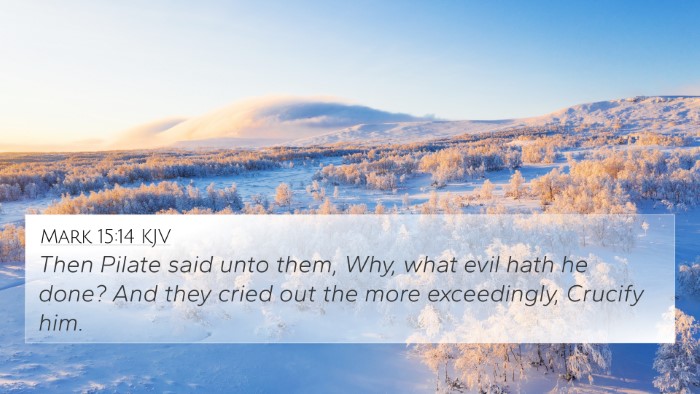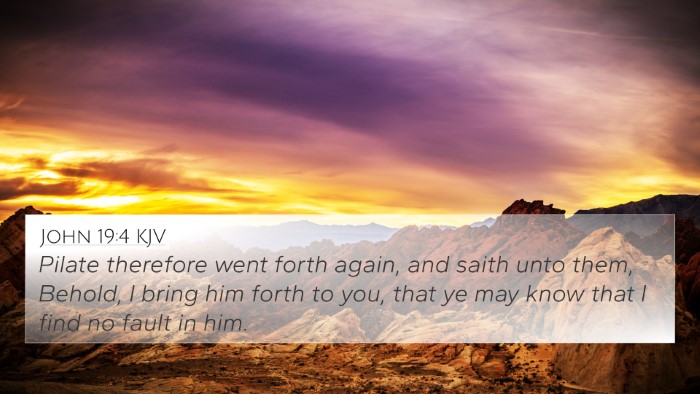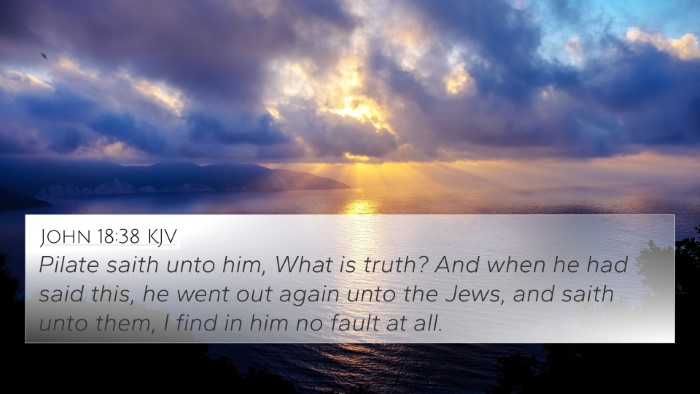Understanding Luke 23:13
Luke 23:13 states, "And Pilate, when he had called together the chief priests and the rulers and the people," This verse describes a significant moment during the trial of Jesus before Pontius Pilate. To adequately comprehend its meaning, we can draw insights from various public domain commentaries, presenting a comprehensive view that facilitates a deeper understanding.
Verse Analysis
This verse highlights Pilate’s interaction with various authorities in Jerusalem regarding the fate of Jesus. The gathering of chief priests, rulers, and the people implies the presence of both religious and political leaders, demonstrating the collaborative involvement in the decision about Jesus’ trial.
Insights from Commentators
-
Matthew Henry:
Henry notes the irony in Pilate’s efforts to appease the Jewish leaders and the crowd. Despite his initial inclination to release Jesus, he ultimately succumbs to the pressure of public opinion, which underscores the theme of accountability and the challenge of moral leadership.
-
Albert Barnes:
Barnes emphasizes the desperate situation of Jesus, illustrating how Pilate attempts to navigate the complex political and social pressures exerted by the influential leaders of the time. He reveals Pilate's struggle between justice and fear, indicating the weakness of human authority when faced with mob mentality.
-
Adam Clarke:
Clarke further explains the dynamics of this assembly. He points out how the solidarity of chief priests and rulers seeking the condemnation of Jesus reflects their vested interests, and how this incident marks a critical point in the opposition against Christ.
Cross-References
Luke 23:13 has multiple biblical connections that enhance our understanding of its context and implications:
- John 18:28-29: Pilate’s initial interaction with Jesus, highlighting the motivations of the religious leaders.
- Matthew 27:1-2: The assembly of the council of chief priests and scribes, foreshadowing Jesus' condemnation.
- Mark 15:1: Describes the early morning gathering of the Sanhedrin, presenting their resolve to hand Jesus over.
- Luke 23:2: The charges brought against Jesus amplify the political maneuvering at the forefront of this trial.
- Luke 12:11: A thematic connection can be made regarding the role of rulers and legal matters in faith.
- Acts 4:27: Reflects on the concerted effort by rulers and people against Jesus, providing a backdrop to this confrontation.
- Isaiah 53:3: Prophesies about Christ being despised and rejected, providing a thematic linkage to the scenario described in Luke 23:13.
Thematic Connections
This verse serves as a critical juncture concerning the themes of authority, justice, and moral conflict. The dynamic between Pilate, an instrument of Roman law, and the Jewish leaders illustrates the complex interplay between spiritual authority and earthly governance.
Practical Applications
Understanding Luke 23:13 is not merely an intellectual exercise but invites us to reflect on our responses to authority and societal pressures. Here are several applications to consider:
- Assess your responsiveness to moral dilemmas in light of ethical leadership.
- Recognize the influence of external pressures on your decisions and faith.
- Engage in understanding the broader social contexts that shape scriptural narratives.
Conclusion
Luke 23:13 is a pivotal scripture that lays bare the complexities surrounding Jesus' trial and the influences of the time. Through examining this verse and its commentaries, we gain valuable insights into the nature of human authority, the weight of public opinion, and ultimately the path that leads to redemption.
For those engaged in deep biblical studies, employing tools for Bible cross-referencing can amplify your understanding of how various verses interact and provide context for themes within their respective narratives.
Further Study
As you delve deeper into the Bible, consider utilizing Bible reference resources like concordances or study guides to identify connections between Bible verses that illuminate broader themes and theological concepts.






